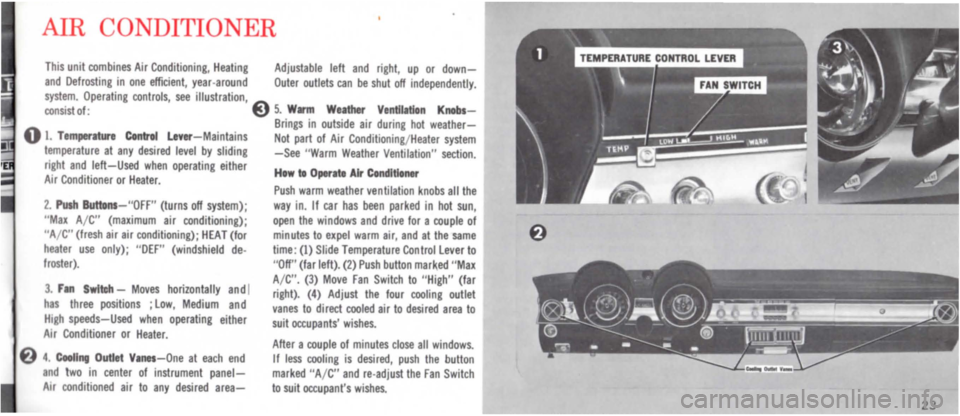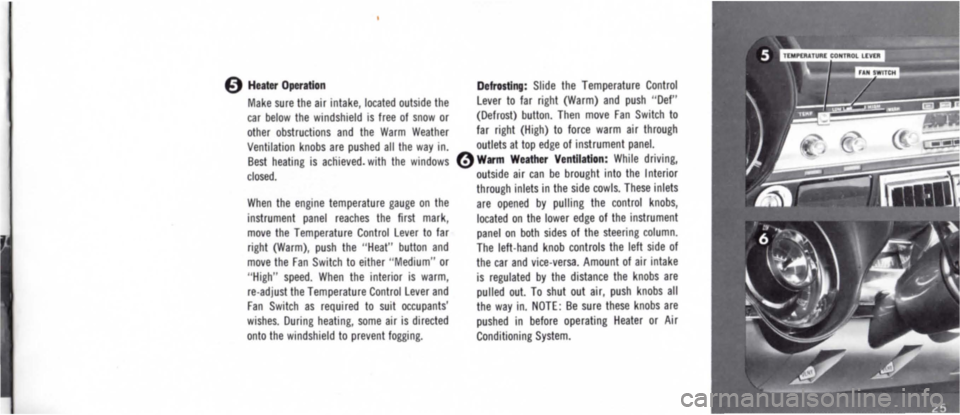1965 DODGE MONACO heating
[x] Cancel search: heatingPage 28 of 46

AIR CONDITIONER
This unit combines Air Conditioning, Heating Adjustable left and right, up or down-
and Defrosting in one efficient, year -around Outer outlets can be shut off independently. system. Operating controls, see illustration, ~ consist of: ~ 5 . WII1tI Weather Ventilition Knob.-
o 1. Temperltln Control Lever-Maintains temperature at any desired level by sliding
right and left-Used when operating either Air Conditioner or Heater.
2. Push Buttons-"OFF" (turns off system);
"Max A /C " (maximum air conditioning); "A/C" (fresh air air conditioning); HEAT (for
heater use only); "DEF" (windshield defroster).
3. Fan Switch -Moves horizontally and I
has three positions ; Low, Medium and
High speeds-Used when operating either
Air Conditioner or Heater.
6 4 . Cooling Outlet Vines-One at each end
nd two in center of instrument panelAir conditioned air to any desired area-
Brings in outside air during hot weatherNot part of Air Conditioning/Heater system
-See "Warm Weather Ventilation" section.
How to Operlte Air Conditioner
Push warm weather ventilation knobs all the
way in. If car has been parked in hot sun,
open the windows and drive for a couple of minutes to expel warm air, and at the same time: (1) Slide Temperature Control Lever to
"Off" (far left). (2) Push button mark.ed "Max
A /C". (3) Move Fan Switch to "High" (far right). (4) Adjust the four cooling outlet vanes to direct cooled air to desired area to
suit occupants' wishes.
After a couple of minutes close all windows. If less cooling is desired, push the button
marked "A/C" and re-adjust the Fan Switch to suit occupant's wishes.
23
Page 30 of 46

o Heater Operation
Make sure the air intake, located outside the car below the windshield is free of snow or
other obstructions and the Warm Weather
Ventilation knobs are pushed all the way in. Best heating is achieved. with the windows
closed.
When the engine temperature gauge on the
instrument panel reaches the first mark, move the Temperature Control lever to far right (Warm), push the "Heat" button and
move the Fan Switch to either "Medium" or
"High" speed. When the interior is warm,
re·adjust the Temperature Control lever and Fan Switch as required to suit occupants'
wishes. During heating, some air is directed
onto the windshield to prevent fogging.
Defrosting: Slide the Temperature Control
lever to far right (Warm) and push "Def" (Defrost) button. Then move Fan Switch to far right (High) to force warm air through
outlets at top edge of instrument panel.
<:) Warm Weather Ventilation: While driving, outside air can be brought into the Interior
through inlets in the side cowls. These inlets are opened by pulling the control knobs,
located on the lower edge of the instrument panel on both sides of the steering column.
The left·hand knob controls the left side of
the car and vice· versa. Amount of air intake
is regulated by the distance the knobs are pulled out. To shut out air, push knobs all the way in. NOTE: Be sure these knobs are
pushed in before operating Heater or Air
Conditioning System.
Page 40 of 46

(CONTINUlU)
CAUTION: To prevent possible wiring damage, certain precautions should be observed: It IS essential when replacing the cables on the battery, or when uSing a "booster" battery, thai the positive cable IS attached to the positive post and the negative cable IS attached to Ihe negative post. The negative cable IS attached to the engine block. Battery posts are marked plus (+ ) and minus (-). Also, If a "fast charger" is used while battery IS in car, disconnect both car battery cables before connecting the charger to battery. Do not use a "fast charger" to provide starting voltage.
which requires the following service attention. Two types are used -one has a wrapper on the carburetor air cleaner, and other does not. With Wrapper: Do the following every 6 months-inspect venhlator valve operation, clean filler cap, InSpect and clean air cleaner element and wash outer wrapper In kerosene and shake or blot dry. Every year-replace ventilator valve. Every two years-replace air cleaner element and wrapper. Without Wrapper: Do the follOWing at each change of engine Oil-inspect ventilator valve operation, Inspect and clean air cleaner element. Every year-replace ventilator valve and replace air cleaner element. More frequent servicing Crankcase Ventilation System. The engine in may be required if the car IS used for short. your car was equipped at the factory with a trip driving and prolonged engine idling. posItive ventilating system to reduce the emission of harmful fumes into the at mos· Ant/·Freele. So that your cooling system Will phere. Periodic and proper inspection and operate without freezing and Without over· cleaning of thiS valve is essential for good heating due to rust formation, the following engine performance and durability. Valve procedures should be observed. operation should be checked every 6 months O . . . by your Dealer, and more frequently if car IS Fall. Open ~adlator dralncock and remo~e used for short-trip driVing and prolonged threaded drain plugs In engine block to drain engine idling. Replace valve once a year. cooling system. Mov~ heat~r selector lever to ''HI'' or "Heat" position (If so eqUipped) to A special crankcase ventilation system is permit draining the heater lines. Thoroughly used on cars built for the state of California flush cooling system with clear water, then
36
close radiator draincock and replace engine block drain plugs. Install MoPar Anti·Freeze (or other high-quality equivalent) to assure cooling system protection for the lowest anticipated temperature in the area where vehicle IS operated dUring the winter months. The cooling system should contain a minimum of 400:, anll-freeze for proper corrosion protection. I n geographiC areas where anli· freeze protecllon IS not necessary, after flushing, fill with clear water and add MoPar Rust ReSistor (or other hlgh·quality co~rosion inhibitor) to prevent the formation of rust deposits. This service IS reqUired annually.
It the vehicle was placed into service after January I , 1965, the first required Fall cooling system service may be eliminated. With the approach of cool weather, however, it IS very important to test the coolant for adequate anti-freeze protection and InSpect the system for eVidence of rust or leaks.
Only glycols and synthetic alcohol (Methanol) are acceptable bases for automobile antifreeze. Solutions containing salts, sugar, honey, glucose, mineral oils, kerosene or similar material should never be used in the cooling system.
@Coolant Level: Have the coolant level checked during each stop at the gasoline station. Add water to bring level to about I-~' below the bottom of the filler neck. Overfilling Will dilute the anti-freeze and also result In coolant loss through the overflow tube. CAUTION: DriVing in heavy traffic, at high altitudes, or In very hot weather may build up pressure in the cooling system. When removing the cap place a cloth over the cap, turn left to first stop, allowing steam to escape through overflow tube, then remove cap.